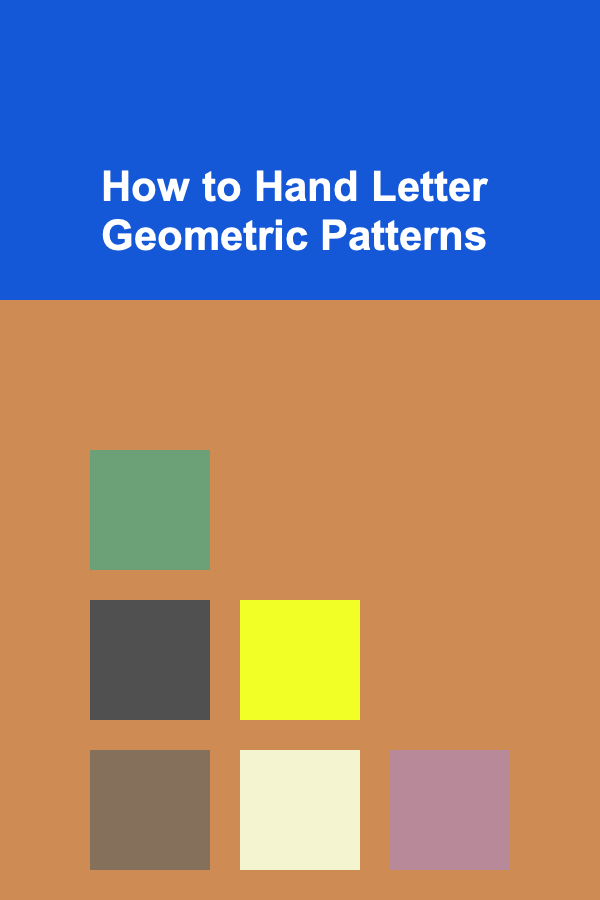
How to Hand Letter Geometric Patterns
ebook include PDF & Audio bundle (Micro Guide)
$12.99$9.99
Limited Time Offer! Order within the next:

Hand lettering is an art form that combines creativity and precision, and geometric patterns are an exciting and visually appealing way to incorporate shapes into your lettering projects. Geometric patterns are often symmetrical, with defined lines, curves, and angles that create a sense of order and balance. When you hand letter geometric patterns, you not only focus on creating beautiful lettering but also work with shapes and structures that support and enhance the overall design.
In this article, we will explore how to hand letter geometric patterns, from understanding basic shapes to adding intricate designs. Whether you're a beginner or an experienced letterer, these steps and tips will help you elevate your hand lettering skills with geometric patterns.
Understand Basic Geometric Shapes
The foundation of any geometric pattern lies in the basic geometric shapes. These shapes are the building blocks that you will use in your hand-lettering projects. Understanding their characteristics and how they can be manipulated will give you more freedom and creativity when designing.
1.1. Circles
Circles are one of the most fundamental geometric shapes. They represent unity, completeness, and symmetry. When incorporating circles into your hand lettering, you can use them for accents, letter shaping, or as part of the background.
- Use in Lettering: Circles can create rounded forms in letters like 'O' or 'Q'. They can also be used to frame or highlight specific words or letters.
1.2. Squares and Rectangles
Squares and rectangles are shapes of stability and structure. Their straight edges and right angles provide a contrast to the soft curves of other shapes.
- Use in Lettering: These shapes can serve as the foundation for letters like 'E' or 'H', or they can be used as part of a border or background pattern to create a sense of balance.
1.3. Triangles
Triangles are dynamic shapes with direction. Depending on how you position them, they can create a sense of movement or stability.
- Use in Lettering: Triangles can be used to create angular letters, such as 'A' or 'V', and they can also serve as the basis for creating more complex patterns in the background.
1.4. Lines
Lines are the simplest geometric element but are crucial for creating structure. They can be horizontal, vertical, diagonal, or curved, each bringing its own unique impact on the design.
- Use in Lettering: Lines can help to separate, underline, or accentuate letters. Diagonal lines can add a sense of motion, while vertical or horizontal lines can add stability and order.
Understanding the role of these basic geometric shapes will help you combine them in creative ways when working on hand-lettered designs.
Choose the Right Tools
Before you begin hand lettering geometric patterns, it's essential to gather the right tools. The right tools will help you achieve clean, precise lines and a professional-looking final product. Here's a list of essential tools for hand-lettering geometric patterns:
2.1. Pens and Pencils
- Pencils: Start with a soft pencil like a 2B or 4B for sketching your designs. Pencils are great for creating guidelines and rough sketches.
- Fineliner Pens: Once you're satisfied with your pencil sketches, use fine-tipped pens for outlining your letters and geometric shapes. Micron pens, or similar fine-liner pens, are perfect for clean lines and intricate details.
- Brush Pens: Brush pens are excellent for creating thick and thin strokes in your lettering. They can be used for both lettering and adding accents to your geometric patterns.
2.2. Rulers and Compasses
For geometric precision, rulers and compasses are essential tools. A ruler helps you draw straight lines, while a compass allows you to create perfect circles and arcs.
2.3. Protractors
If you're working with angles or need to create specific geometric patterns, a protractor is helpful for ensuring your angles are consistent.
2.4. Erasers
Use a good-quality eraser to clean up any pencil marks after outlining your letters and shapes. A kneaded eraser is especially useful for gently lifting off graphite without smudging.
2.5. Tracing Paper
If you want to refine your designs or transfer them onto a different surface, tracing paper is invaluable. You can sketch your pattern, then trace it onto your final piece without disturbing the initial design.
Plan Your Layout
A key to successfully incorporating geometric patterns into your hand-lettering is to plan your layout carefully. This includes deciding on the overall shape of the lettering, the placement of the geometric elements, and the amount of space between your designs. Planning will help ensure that the geometric elements enhance the lettering without overpowering it.
3.1. Start with a Grid
Using a grid is a helpful way to maintain consistent spacing and alignment in your hand-lettering. A grid will guide you as you add geometric elements, making sure they are proportional and symmetrical.
- Rule of Thirds: You can also apply the rule of thirds to divide your page into sections, allowing you to position your text and patterns in a more dynamic, visually engaging way.
3.2. Experiment with Different Letterforms
Consider how your chosen geometric shapes will interact with your letters. For example, try adding straight lines, curves, or circles to your lettering to enhance their shape. You can modify the typical letterforms to make them more angular, rounded, or abstract, depending on the patterns you want to incorporate.
3.3. Use Negative Space
Incorporating negative space is crucial when working with geometric patterns. The empty spaces between the shapes and letters help the design breathe and prevent it from feeling too cluttered. Play with the arrangement of the geometric shapes to ensure that there is a balance between positive and negative space.
Create the Geometric Pattern
Once you've planned the layout, it's time to start creating the geometric pattern. This is where you'll apply the shapes and lines that complement your lettering. Here are a few ways to incorporate geometric elements into your design:
4.1. Geometric Borders
One of the simplest ways to use geometric patterns in hand lettering is by adding borders around the lettering. This can be done with circles, squares, or repeating lines. A clean, simple border can frame your letters, drawing attention to the words while maintaining a minimalist aesthetic.
4.2. Patterned Backgrounds
Another option is to use geometric patterns as backgrounds. This can involve repeating triangles, hexagons, or circles behind your lettering, adding depth and texture without distracting from the main text. The key is to keep the background subtle so that the lettering remains the focal point.
4.3. Lettering with Geometric Shapes
You can directly incorporate geometric shapes into the letterforms themselves. For example, you could replace parts of a letter (like the loop of an 'O' or the crossbar of an 'H') with a geometric pattern or shape. This creates an integrated design where the geometric shapes and letters flow together seamlessly.
4.4. Overlapping and Layering
Layering geometric shapes over your letters can create a dynamic, multidimensional look. For example, you might have a set of concentric circles that overlap your letters, creating a sense of movement or depth.
Add Details and Final Touches
Once your basic geometric pattern is in place, it's time to refine the design. Add intricate details, such as lines, shading, or texture, to make your pattern stand out. Here are some techniques to enhance your design:
5.1. Line Work and Detailing
Use a fine-liner pen to add additional lines or details to your geometric shapes. For example, you could add thin lines around the edges of the shapes to create a shadow effect or add a pattern within the shapes to make them stand out more.
5.2. Shading and Contrast
Shading can add depth and dimension to your design. Use hatching or cross-hatching techniques to create shadows or highlight certain areas of your geometric shapes. Experiment with light and dark contrasts to make your lettering and patterns pop.
5.3. Coloring
You may also want to add color to your geometric patterns and lettering. Colored pencils, watercolors, or markers can be used to fill in the shapes, enhancing the visual appeal. When choosing colors, consider using a color palette that complements the geometric pattern and creates harmony within the design.
5.4. Finishing Touches
Finally, add any last-minute touches, such as small dots, sparkles, or other decorative elements that can elevate the overall look. Be careful not to overdo it---sometimes less is more, and subtle details can make a big impact.
Practice and Experiment
Hand lettering with geometric patterns takes practice. The more you experiment with different shapes, layouts, and designs, the more comfortable you will become with incorporating geometric elements into your lettering projects. Don't be afraid to make mistakes along the way; each error is a learning experience that will improve your skills.
Conclusion
Hand lettering with geometric patterns is an exciting and visually dynamic way to elevate your creative projects. By understanding the basic geometric shapes, selecting the right tools, planning your layout, and incorporating intricate details, you can create designs that are both beautiful and structured. Whether you're working on a greeting card, a quote poster, or a personal project, geometric patterns will add depth, symmetry, and balance to your hand lettering.
So grab your pens and start experimenting with different shapes and layouts---there's no limit to the creative possibilities that geometric patterns can bring to your hand-lettering designs!
Reading More From Our Other Websites
- [Home Lighting 101] How to Create a Cozy, Hygge-Inspired Home with Lighting
- [Organization Tip 101] How to Keep Track of Your Hobby Expenses Efficiently
- [Home Pet Care 101] Pet-Friendly Car Essentials for Safe and Comfortable Travel
- [Home Family Activity 101] How to Organize a Family Fashion Show at Home
- [Home Budget Decorating 101] How to DIY Cheap Decorations for Your Room on a Tight Budget
- [Personal Care Tips 101] How to Use Cuticle Oil to Reduce Nail Fungus
- [Personal Financial Planning 101] How to Use the Best Money Management Apps to Track and Grow Your Finances
- [Personal Care Tips 101] How to Apply Makeup Primer for Long-Lasting Makeup
- [Organization Tip 101] How to Utilize Under-Bed Storage Effectively
- [Small Business 101] How to Set Up a Pop‑Up Retail Experience for a Handmade Candle Business During Holiday Seasons

How Free Online Courses Can Help You Learn New Skills Without Breaking the Bank
Read More
How to Balance Saving for the Future and Enjoying the Present
Read More
How to Build a Checklist for Checking Website Functionality
Read More
How to Store and Organize Holiday Gifts Before Wrapping
Read More
How to Use Overhead Storage to Free Up Living Areas
Read More
How to Prepare for Long-Distance Cycling Tours
Read MoreOther Products

How Free Online Courses Can Help You Learn New Skills Without Breaking the Bank
Read More
How to Balance Saving for the Future and Enjoying the Present
Read More
How to Build a Checklist for Checking Website Functionality
Read More
How to Store and Organize Holiday Gifts Before Wrapping
Read More
How to Use Overhead Storage to Free Up Living Areas
Read More